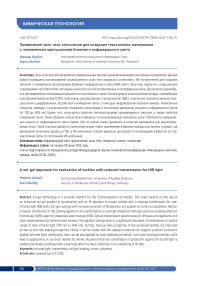A sol - gel approach for realization of textiles with reduced transmission for NIR light
Автор: Jakubik M., Mahltig B.
Журнал: Вестник Витебского государственного технологического университета @vestnik-vstu
Рубрика: Химическая технология
Статья в выпуске: 1 (47), 2024 года.
Бесплатный доступ
Sol - gel technology is a versatile method for the functionalization of textiles. This study reports on the use of an industrial sol - gel product in combination with an IR absorber to create textiles with a reduced transmission for near infrared light (NIR light). Sol - gel coatings with increasing content of IR absorber are applied on cotton and polyester fabrics. A regular distribution of the coating agents on the textile fabrics is reached. Analytical methods used are scanning electron microscopy (SEM), electron dispersive spectroscopy (EDS), optical transmission spectroscopy in diffusive arrangements and heat measurements by infrared heat camera. The applied coatings lead to a significant decrease of transmission in optical range of near infrared light (700 nm to 1400 nm). Further, heat up - take properties of the produced textiles are improved as well as the heat keeping properties. Finally, it can be stated that the realized materials can support a certain protection against infrared light. Additionally, they can be also applied as heat collecting materials. Such dual functional textiles could lead to applications in out - door clothes for winter situation there the combination of protection against UV and IR light is wished and ideally combined with a warming effect by heat collections from absorbing of IR light.
Coating, infrared light, transmission, sol-gel, cotton, polyester
Короткий адрес: https://sciup.org/142240877
IDR: 142240877 | УДК: 677.027 | DOI: 10.24412/2079-7958-2024-1-64-70
Текст научной статьи A sol - gel approach for realization of textiles with reduced transmission for NIR light
DOI:
Article info: received June 03, 2023.
The article was prepared based on the report of the International Scientific and Technical Conference "International Conference on Textile and Apparel Innovation ICTAI–2023".
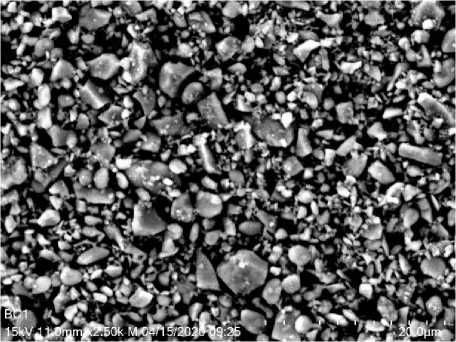
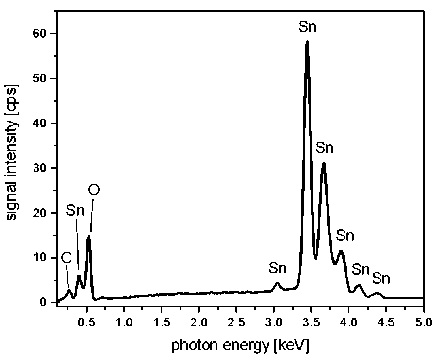
Figure 1 – Microscopic image (left) and EDS-spectrum (right) of Colorsil material. In the EDS-spectrum the chemical elements related to the signals are indicated
Colorsil can be homogeneously distributed into the gel. The Colorsil concentration is set in the range from 1wt-% to 15wt-%. This gel is used as coating agent on the textiles. Drying and fixation is done at 120°C. Analytical methods used for the investigation of the coated textiles are scanning electron microscopy (SEM), electron dispersive spectroscopy (EDS), optical transmission spectroscopy in diffusive arrangements and heat measurements by infrared heat camera.
The applied sol-gel materials are regularly distributed on the textile surfaces as shown by SEM images recorded in different magnifications (Figures 2 and 3). Due to the rougher structure of the cotton fabric, the used cotton materials take up more of the applied sol-gel recipe.

Figure 2 – Microscopic images of cotton fabric untreated and after different coatings. Images with low magnification are shown on the left side and with high magnification on right side
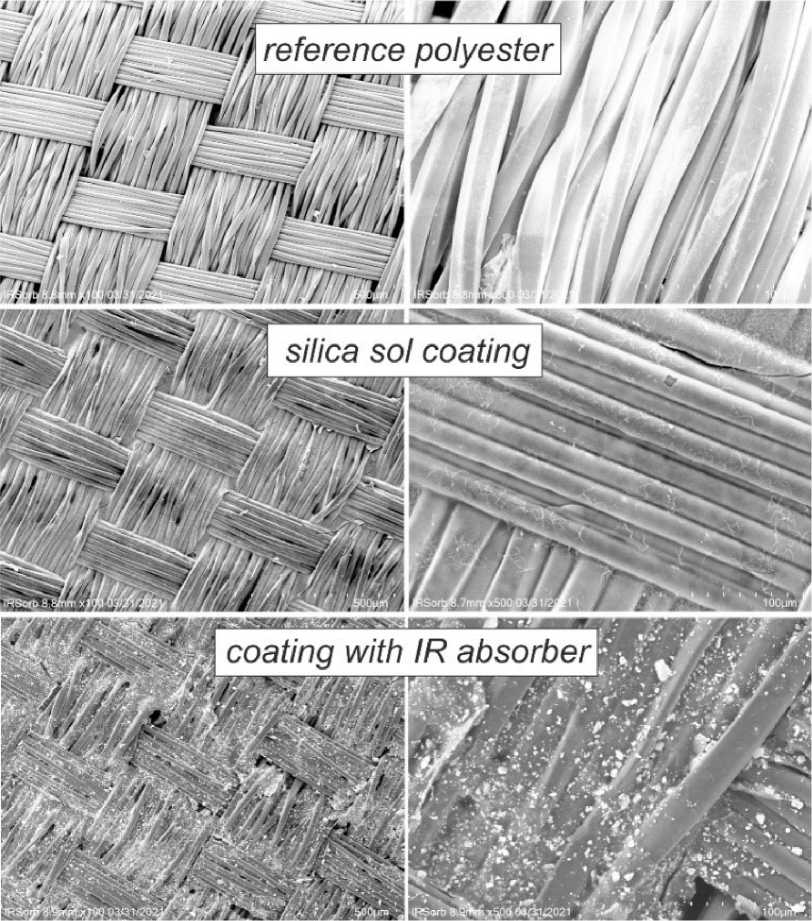
Figure 3 – Microscopic images of polyester fabric untreated and after different coatings.
Images with low magnification are shown on the left side and with high magnification on right side
The optical transmission of realized textile samples is recorded for the spectral range from 220 to 1400 nm (Figure 4). Here the diffusive transmission is determined using an integrating sphere. Also, for UV light (range 220 to 400 nm) and visible light (range 400 to 700 nm) a decrease in optical transmission can be determined after the sol-gel coating with the IR absorber are applied.
A significant decrease in transmission for near infrared light in the spectral range from 700 to 1400 nm can be also determined. However, for a significant decrease in transmission the content of IR absorber has to be 10 % or more in the coating recipe. The effect is stronger for the application on cotton fabrics (compared to the polyester fabrics), probable because of the higher up-take of the
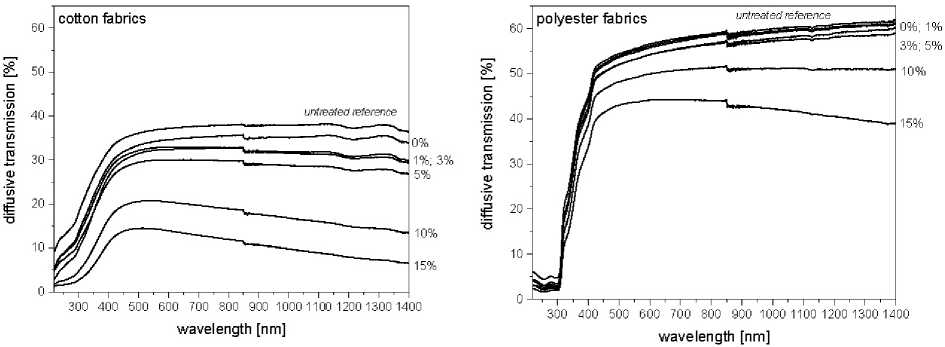
Figure 4 – Optical spectra of diffusive transmission shown for fabrics coated with increasing amount of IR absorber. Cotton fabrics (left) and polyester fabrics (right)
recipe by the rougher cotton fabric.
As additional property the heat up-take capability is determined for the realized samples. Infrared radiation is also known as heat radiation and their up-take by an IR absorber should lead to an enhanced warming of the samples. Such a warming can be determined as increased temperature in case of exposition to a source for IR light (as an IR lamp). In current investigations such a temperature increase in case of IR illumination is determined with a heat camera over a duration of six minutes. The starting temperature is set to around 26 °C and the temperature increase is presented as difference to this starting temperature as function of the content of IR absorber in the applied coating (Figure 5). The heat up-take increases as function of IR absorber content in the coating. For the coatings on the cotton fabrics, this effect can be even determined for the lowest investigated content of IR-absorber of 1 wt-%. Figure 5 shows the temperature increase of the samples after two minutes and six minutes of heating by IR lamp. For most samples, the temperature increase is for both durations nearly similar, so the equilibrium of heat up-take and cooling process is almost reached after the short duration of two minutes.
Additional to the heat up-take capability, also the heat keeping properties are determined by recording the duration which is necessary to cool down the samples to the original temperature of around 26 °C. For this, the
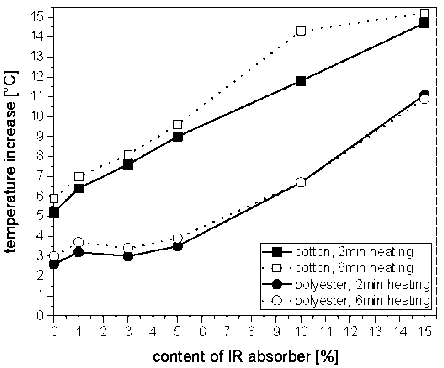
Figure 5 – Heat up-take shown for fabrics coated with increasing amount of IR absorber. The heat up-take is presented as temperature increase after placement under a heat lamp for two or six minutes cooling duration is measured after heating of the samples for six minutes with the IR lamp. This cooling duration increases directly as function of IR absorber content in the coating recipe (Figure 6). Significant effects are gained if the IR absorber content is 5 % or higher. For this, it is clear not only the heat up-take capability can be enhanced by the applied coating – also the capability to hold the once up-taken heat is improved.
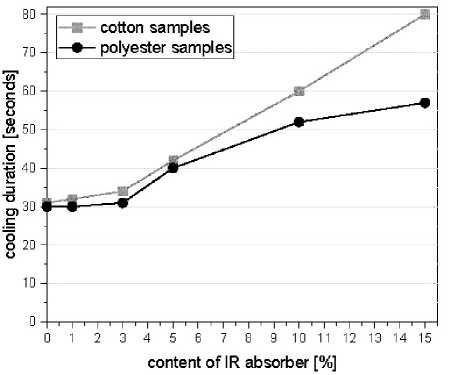
Figure 6 – Cooling duration after deposition of samples under a heat lamp for six minutes
Finally, it can be stated that the used sol-gel recipes can be used as coating agents on textile fabrics to realize materials with offer a certain protection against infrared light. Additionally, these coated textiles can be also applied as heat collecting materials. Such dual functional textiles could lead to applications in out-door clothes for winter situation there the combination of protection against UV and IR light is wished and ideally combined with a warming effect by heat collections from absorbing of IR light. These are interesting approaches for possible application. To make the next steps, further fastness properties of the coating and an evaluation according to eventual environmental issues have to be done.
Список литературы A sol - gel approach for realization of textiles with reduced transmission for NIR light
- Barolet, D., Christiaens, F. and Hamblin, M.R. (2016). "Infrared and skin: Friend or foe", Journal of Photochemistry and Photobiology B: Biology, vol. 155, pp. 78-85. EDN: WSMTBH
- Mahltig, B., Zhang, J., Wu, L., Darko, D., Wendt, M., Lempa, E., Rabe, M. and Haase, H. (2017). "Effect pigments for textile coating: a review of the broad range of advantageous functionalization", Journal of Coatings Technology and Research, vol. 14, pp. 35-55. EDN: YWOFVN
- Maity, S., Singha, K., Debnath, P. and Singha, M. (2013). Textiles in electromagnetic radiation protection," Journal of Safety Engineering, vol. 2, pp. 11-19.
- McDaniel, D., Farris, P. and Valacchi, G. (2018). "Atmospheric skin aging-Contributors and inhibitors", Journal of Cosmetic Dermatology, vol. 17, pp. 124-137.
- Rubežienė V., Padleckienė I., Baltušnikaitė J. and Varnaitė, S. (2008). "Evaluation of camouflage effectiveness of printed fabrics in visible and near infrared radiation spectral ranges", Mater Sci-Medzg, vol. 14, pp. 361-365.
- Sayed, U., Tiwari R. and Dabhi, P. (2015). "UV protection finishes on textile fabrics", Int. J. Adv. Sci. Eng. vol. 13, pp. 56-63.
- Viola, W., Zhao, P. and Andrew, T.L. (2023). "Solar thermal textiles for on - body radiative energy collection inspired by polar animals", ACS Applied Materials & Interfaces, vol. 15, pp. 19393-19402. EDN: ZQAKUY

